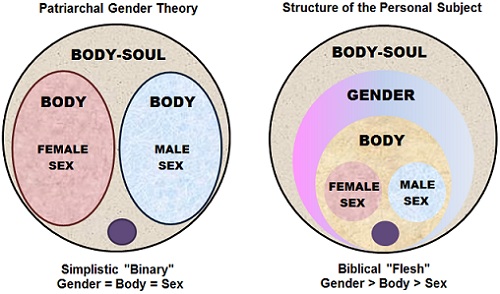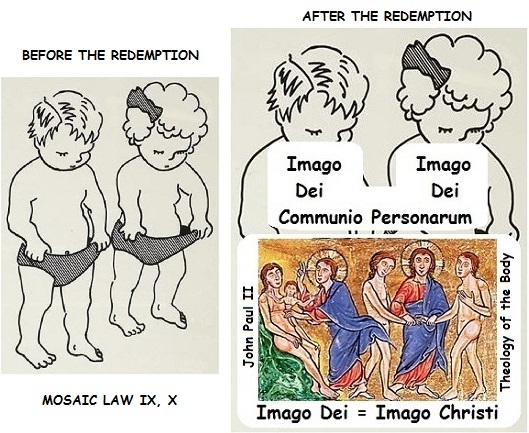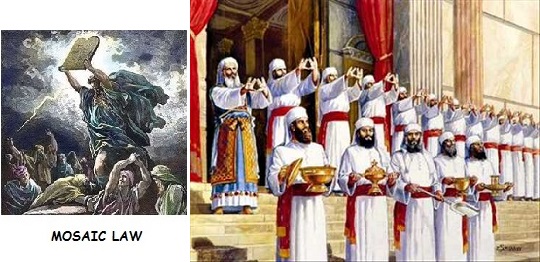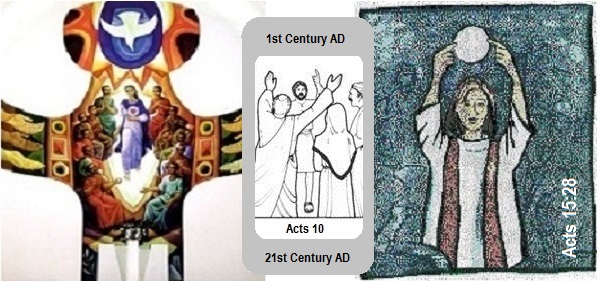|
|
|
Meditation Seeking Understanding ~ Humanity
These pages are meditations on the mysteries of the creation, the incarnation, and the redemption. They explore the Christian understanding that all men and women are consubstantial in one and the same human nature, and are consubstantial with Jesus Christ as to his humanity. The meditations are based on a layman's reading of the Sacred Bible, the Catechism of the Catholic Church, and the Theology of the Body as they pertain to the egalitarian complementarity of man and woman, which transcends the patriarchal binary of mutually exclusive male-female opposites. This understanding of the "unity in complementarity" of man and woman applies to all the sacraments, sheds light on the great nuptial mystery of Christ and the Church, and would seem to support the ordination of women to the ministerial priesthood and the episcopate.
|
Unitive Complementarity of Man and Woman
Working Draft - 1 October 2016
PRAELUDIUM 1 - On the ecclesial impasse, 2016 AD
In the Catholic Church, the resistance to the ordination of women is rooted in a sacramental theology that conflates the patriarchal gender binary with biblical revelation. This is a meditation on human nature, male and female, as it pertains to the sacramental priesthood of the New Law when unconstrained by the patriarchal priesthood of the Old Law. This is a visceral issue that cannot be settled by reasoning alone. This page attempts to support prayerful discernment by stepping outside of the patriarchal box and reconsidering the issue in light of the deposit of faith and the signs of the times.
|
PRAELUDIUM 2 - On human nature and the personal subject
"Bodiliness and sexuality are not simply identical. Although in its normal constitution, the human body carries within itself the signs of sex and is by its nature male or female, the fact that man is a "body" belongs more deeply to the structure of the personal subject than the fact that in his somatic constitution he is also male or female. For this reason, the meaning of "original solitude," which can be referred simply to "man," is substantially prior to the meaning of original unity; the latter is based on masculinity and femininity, which are, as it were, two different "incarnations," that is, two ways in which the same human being, created "in the image of God" (Gen 1:27), "is a body."" The Meaning of Original Unity, Pope John Paul II, 7 November 1979 (Source: Man and Woman He Created Them: A Theology of the Body, Pauline Books, 2006, page 157. See also note 12 in page 158.
|
Acronyms and Links:
|
UNITIVE CONSUBSTANTIALITY OF MAN AND WOMAN
|
The body is a sacrament of the entire person but is not the entire person. From the begining, the human person, man and woman, was created as a "body-soul" reality that subsumes the "body-gender" reality, which in turn subsumes the "biophysical body" reality, which in turn subsumes many other realities such as biological sex, the five senses, the color of the skin, etc. All men and women are made of the same created dust, the same created flesh, animated by the same kind of created soul. All men and women are naturally consubstantial, with unity in diversity in the image of the Trinity. That the second person of the Trinity became incarnate as a male means that God assumed all the limitations of the human condition ("like us in all things but sin") without in any way ceasing to be a divine person. Consider the following diagram:

Colors: Grey = Biblical "Flesh" (Human Nature), Beige = Body, Pink = Female, Blue = Male, Purple = Intersex.
NB: The grey (biblical "flesh," i.e., human nature) subsists under the other colors for all humans. Christ is 100% human and 100% divine. Each person is distinct (solid borders), but all human beings are made of the same flesh.
This diagram, like all models, is a simplification of reality, but attempts to deconstruct the oversimplistic sex/gender binary of the patriarchal culture. Basically, it means that each human being is a body animated by a soul (gray circle). All men and women are fully homogeneous, made of the same dust, of the same substance, of the same flesh; and share one and the same human nature (brown circle). The body of each person is sexually differentiated, and is male *or* female *or* intersex (pink, blue, and purple circles). So, again, the body is a visible sacrament of the entire person, but is not the entire person. The physical body makes visible the invisible metaphysical person, but is not the entire person.
Sex is biophysical. Gender (gradient pink-blue circle) is psychosomatic, a personal synthesis of somatic constitution and cultural conditioning. Sex and gender are constitutive of the human person more deeply that other, more superficial attributes such as skin color, height, and weight; but all men and women are homogeneously constituted of the same flesh in one and the same human nature. The sexual complementarity of man and woman does not limit them to mutually exclusive roles except when they come together to share the gift of love and the gift of life. Modern science (biology, psychology, neurology) has shown ancient cultural stereotypes to be unnatural. In contrast to the patriarchal mindset of male domination and female subordination, a healthy complementarity of man and woman actually requires their joint participation in most human activities and the reconstruction of their interpersonal communion as fully equal partners in the nuclear family, and in the Church as the family of God, including apostolic succession.
The body is a sacrament of the entire person but is not the entire person. Other than genitally, the complementarity of man and woman does not mean mutually exclusive roles. Such mutual exclusion of gender roles is a heritage from radical patriarchy, not divine revelation. All humans are consubstantial in one and the same human nature. Our Lord Jesus Christ is consubstantial with all humans in his humanity. The Eucharist is the flesh and blood of Christ. Metaphysical "transubstantiation" happens when the priest consecrates the bread and wine, but is really consummated in the flesh when the person who receives the Eucharist becomes "eucharist" in sacrificial service to others.
|
FROM ORIGINAL SIN TO THE INCARNATION

From the Shame of Original Sin to the Incarnation
Genesis 3:16, 2:7, 18-24; 5:1-2, 3-32, 11:10-32, 12:1-3, 21:10; Exodus 3:15, 20:17; Leviticus 12:1-5; Numbers 3:1-15; Deuteronomy 21:10-13; Matthew 1:1-17, 13:3-38, 19:12; Luke 3:23-38; John 1:1-14, 4:23-27, 16:2-13, 17:16, 20:17; CCC 145, 239, 370, 706, 762, 1669, 2676, 2779; TOB 22:5, 27:2, 29, 30, 31, 32, 33
Images: Peccato Originale - Crestin Ortodox and Annunciation/Incarnation - Catholic Books
Point 1: After original sin and the inception of the patriarchal gender binary, the father is the head of the family. The divine feminine is suppressed, and God becomes exclusively male in the image of human patriarchs.
Point 2: Before the incarnation, in this patriarchal culture, wives are the posession of their husbands. Patriarchy is not a intrinsically evil (nothing human is 100% good or 100% bad) but it is an objective cultural disorder derived from original sin.
QUESTIONS: Jesus is the "Son of Man," but was the "Son of God" a male before the incarnation? For the redemption and the sacramental economy, is the human masculinity of Jesus more important than the color of his skin or the color of his eyes?
Point 3: God is Love, a pure spirit. Before the incarnation, God did not have a body. At the incarnation, the second Person became flesh in time and space, in a concrete human body, with a concrete patriarchal genealogy, like us in all things but sin. Starting with Mary's free decision at the Annunciation (without asking for Joseph's permission!), the incarnation turned the patriarchal culture upside down and inside out, albeit in a humble way that tolerated resistance to change, not by force.
|
BEFORE AND AFTER THE REDEMPTION

One Flesh, Before and After the Redemption of the Body
Genesis 2:18-24, 12:1-3, 21:10; Exodus 20:17; Leviticus 12:1-5; Numbers 3:15; Deuteronomy 5:21, 21:10-13; Matthew 8:20, 18:11; Mark 10:35-45, 16:1-3; Luke 2:46, 9:58; John 1:1-14; Romans 8:23; Galatians 4:4; Philippians 2:6-8; Hebrews 4:14, 10:5; CCC 145, 706, 762, 1669, 2676; TOB 8:1, 4, 9:1-5, 10:1-4, 19:3-5, 29:1-5, 30:3-5, 31:3-5, 32:3-5, 33:2, 44:6, 55:2-6, 58:3, 59:3, 65:3, 66:1-3, 67:3, 68:1, 69:4-6, 70:5-7, 75:3, 76:6, 78:5, 80:4, 86:1-4, 87:5, 89:1-8, 90:5, 91:6, 92:6, 95:1-7, 95b:1, 96:5, 97:5, 102:4, 116:5, 117b:6, 122:1, 123:7, 129:3-5, 130:5, 133:1
Image: Boy and Girl, Artist Unknown - Union History
Point 1: The original unity of man and woman as created rational animals, and their interpersonal communion, are distorted by the patriarchal gender binary in the culture of ancient Israel. This is a distortion made by human hands, not God's.
Point 2: What really matters for the Christian faith is that God became human, in the flesh, not that he was incarnated as a male. Jesus identified himself as the Son of Man, a human being; he never identified himself as a patriarch. For the redemption, and for the sacramental economy of the New Law, his masculinity is as incidental as the color of his eyes.
Point 3: Jesus Christ is Son of God and Son of Man, one divine Person with two natures, divine and human. The Son of God is "eternally begotten," a divine person that transcends all human limitations of time and space, including sex and gender. Before the incarnation, God is God. After the incarnation, God is God and is, in addition, a human being.
|
OLD LAW, PATRIARCHAL PRIESTHOOD

The Mosaic Law and the Patriarchal Priesthood of the Old Testament
Genesis 3:16, 12:1-3, 21:10; Exodus 20:17; Leviticus 12:1-5; Numbers 3:15; Deuteronomy 5:21; Luke 2:22-40; John 4:27, 16:12; Galatians 4:4; CCC 145, 706, 762, 1669, 2534, 2676; TOB 2:4, 4:3, 5:5-6, 6:3, 8:1, 10:1, 19:4, 21:3, 45:1, 44:6, 55:2, 60:1-2, 69:2, 72:5, 85:9, 86:4, 93:3, 95:6, 99:4, 102:5, 119:4
Image: God & Moses,
Melchizedek and Levitical Priesthoods
Note 1: The 9th and 10th commandments tacitly assume that, together with other assets, wives were the property of their husbands. Lamentably, this patriarchal mindset still prevails in some regions of the world, and even in some Christian communities.
Note 2: The Melchizedek priesthood spanned from Adam to Moses (Romans 5:14) until the Gold Calf Covenant Break of Israel (Exodus 32), thrusting the people into a Levitical lriesthood (Hebrews 7:11) until Yahweh re-established the Melchizedek priesthood thru Jesus (Psalm 110:1-4, Hebrews 7:20-24). Both were patriarchal priesthoods, i.e., exclusively male in conformance with Genesis 3:16.
Point 1: Time and place: Israel, before the incarnation and the redemption. Jesus of Nazareth was born under the Law. His parents were subject to the Law and he willingly remained subject to the Law. The ten commandments, good as they are, already reflect contamination by the patriarchal culture of male domination and female subordination.
Point 2: The Old Law is understood and articulated as a patriarchal covenant between a God that looks like a divine Patriarch and a people ruled by Moses and other human patriarchs. The father is the head of the family. It is a phallocentric culture of patriarchal domination, of women by men, and of nature by men.
Point 3: It is divine pedagogy that God comes to us where we are. To reveal the divine plan for the New Law by way of a public ministry that could reasonably unfold in patriarchal Israel, it was reasonable for the Lamb of God to incarnate as a male.
|
NEW LAW, SACRAMENTAL PRIESTHOOD

The Church and the Sacramental Priesthood of the New Law
Genesis 3:16, 12:1-3, 21:10 49:28; Exodus 20:17; Leviticus 12:1-5; Numbers 3:15; Deuteronomy 5:21, 21:10-13; Isaiah 42:1-7, 54:7-10; Jeremiah 29:11; Hosea 6:6; Matthew 9:13, 16:19 18:18; Mark 1:29-39; John 4:27, 16:12-13; Acts 10:34, 15:28; CCC 145, 706, 762, 1669, 2676; TOB 2:4, 5:5-6, 6:3, 8:1, 10:1, 19:4, 21:3, 45:1, 44:6, 55:2, 60:1-2, 69:2, 72:5, 85:9, 86:4, 95:6, 99:4, 102:5, 119:4
Images: Fraternidad Monástica Virtual
and Wijngaards Institute for Catholic Research
Point 1: Redemption, Pentecost, and the Church
For the redemption and the sacramental economy, the masculinity of Jesus is as incidental as the color of his eyes. After Pentecost, the Church is free from the Jewish culture or any other culture, including the patriarchal culture that predated biblical times but emerged after original sin. By the power of the keys, the Church does have the authority to enhance apostolic succession by ordaining women to the priesthood and the episcopate.
Point 2: The Sacramental Economy - Seven Sacraments
The dogmatic definition on the institution of the priesthood of the New Law (Trent, 1563) does not mention a masculinity requirement for apostolic succession. The male-only priesthood is not a dogma of the Catholic faith. The natural consubstantiality of man and woman, as it is now understood, makes clear that the pre-Easter choice of the 12 male apostles should not be taken as divine law that excludes women from ordination. The Church is "one, holy, catholic, and apostolic," but not necessarily patriarchal.
Point 3: The Sacramental Priesthood of the New Law
In our "already/not yet," it is time to renounce ecclesiastical patriarchy. The patriarchal culture is passing away, and families are evolving from sole male (father) headship to joint male-female (father-mother) headship. To continue the process narrated in Acts 15, when the Church transitioned out of the Jewish culture, it is time for the Church to let go of patriarchal gender ideology, which predates biblical times but is not essential for the Catholic faith.
For the redemption and the sacramental economy, what matters is that the Word became flesh, his embodied masculinity being as incidental as the color of his eyes. The male-only priesthood may have seem reasonable in the past but is now becoming a liturgical calamity that reduces the sacred mysteries to a patriarchal gender theory.
|
COLLOQUIUM 1 - Consubstantiality and Complementarity
|
Considerations on natural consubstantiality and unitive complementarity in the sacramental life of the Church:
1. Catechism 1577 is not a literal but a literalist interpretation of the twelve male apostles. It ignores that Jesus was making a choice in the context of his earthly mission to the people of Israel, taking into account what they "knew" about governance ("twelve patriarchs") and about sex/gender ("women are defective males"). It is absurd to keep insisting that such a contingent choice is normative after the resurrection and Pentecost.
2. Catechism 1598 literally says that the exclusively male priesthood is a choice (first sentence) and who has the authority to make the choice (second sentence).
3. Ordinatio Sacerdotalis was an undoubtedly well intended edict to support the doctrine of Catechism 1577 and reaffirm apostolic authority, but the time has come to end the hiatus on further discussion of this doctrine. Apostolic succession is not contingent on masculinity. Stone walling on this issue is doing much harm to the body of Christ and to the entire community of creation.
4. The Theology of the Body (TOB) provides a sound foundation, but must be extended to all the seven sacraments, including HOLY ORDERS. The TOB is not about man versus woman; it is about man and woman sharing the same homogeneous flesh and living in interpersonal communion. The TOB is about difference in unity, a unitive complementarity, not a complementarity of gender stereotypes. For the redemption, and the sacramental economy, the embodied masculinity of Jesus is as incidental as the color of his eyes. All human differences, including sex and gender differences, were restored to the original "unity in diversity" by the redemption of the body. Any baptized person, male or female, can be ordained to act in persona Christi. All ministries must be discerned based on vocation, not gender.
5. Even in the conjugal act, genital complementarity is for attaining unity ("one flesh"). The analogy of the "bridegroom" and the "bride" should not be reduced to patriarchal gender stereotypes that are no longer conducive to the glory of God and the good of souls. The Christ-Church mystery is not simply a patriarchy. It is not insignificant that Ephesians 5:22-33 is rarely chosen anymore as a reading in Catholic weddings. It is time to put an end to the pseudo-ontological complementarian nonsense in the sacramental life of the Church.
6. Canon 1024 is, in effect, an artificial contraceptive (if not an abortifacient) of female priestly vocations. Aborting vocations is almost as bad as aborting babies. For the new evangelization, we need women deacons, women priests, and women bishops.
7. Are we integrally pro-life from conception to natural death? Do we really care about "integral human development" and "integral ecology"? Can we effectively promote this agenda while still having a church hierarchy that is an image of patriarchal ideology rather than Trinitarian communion?
|
COLLOQUIUM 2 - Sentire cum Ecclesia
This meditation does not attempt to "prove" anything. It is a personal reflection about a visceral issue that cannot be resolved by reasoning alone, and prayerful discernment of Christ's will is required. The truth is timeless, but the Church's understanding of the truth is not timeless; the faith is always the same but the Holy Spirit enables the Church to bring out of the deposit of faith what is new and what is old (cf. Matthew 13:52).
Lord, grant me the serenity to accept what I cannot change,
The courage to change what I should change,
And the wisdom to know the difference.
Mary, Mother of the Church and Untier of Knots, pray for us.
Ad Majorem Dei Gloriam et Bonum Animarum
|
|Back to Title|
PelicanWeb Home Page
Index of Meditations
|
|
|
|